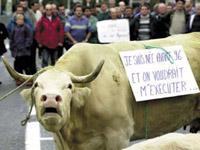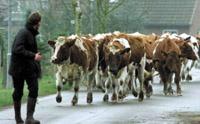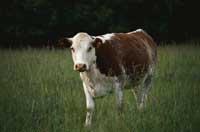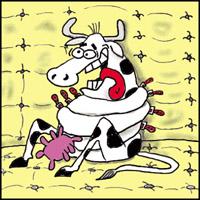Text written in Basque and translated automatically by Elia without any subsequent editing. SEE ORIGINAL
Chronology of mad cow disease
2001/01/01 Kortabarria Olabarria, Beñardo - Elhuyar Zientzia Iturria: Elhuyar aldizkaria
- 1732, first case Scrapie.
- 1883, vibration of the first cow.
- 1920, begins to use flour to feed animals in advanced countries.
- 1920, Creutzfeldt-Jakob describes the disease.
- 1936, scientists Cuillé and Coll showed that Scrapie is transmissible.

- 1947, scientist Hadlow related Kuru's disease to Scrapie's disease.
- 1958, Dr. Gadjus, after demonstrating that Creutzfeldt-Jakob disease was transmitted, received the Nobel Prize in Medicine.
- 1970, after the vaccination of Louping ill, many sheep became ill in Britain from Scrapie.
- 1978, drastic measures in Iceland to eliminate scrapie. At the same time, the Icelanders discovered the international risk of this disease.
- 1981. Decreased temperatures in the process of making food flours.
- 1982, American Stanley Prusiner "invented" the prions and reported on his reproductive system. He received numerous adverse reactions.
- 1984, in the case of Creutzeldt-Jakob syndrome after taking growth hormone.
- 1985, Japanese researcher Tahsteishi demonstrated that Creutzeldt-Jakob syndrome could also be transmitted through the blood.
- 1986, as a result of the adoption of growth hormone, about 30 young people developed Creutzeldt-Jakob syndrome.
- 1986. Bovine spongiform encephalopathy was officially recognized in Britain.
- 1988, food flours were banned in Britain and the death of all cows in danger of illness was accepted. It was prohibited to take milk from suspicious animals, as well as the use of waste to make infant meals.
- 1989, according to a study at Yale University in the United States, 13% of Alzheimer's cases were Creutzfeldt-Jakob syndrome.
- 1990, a British cat suffers for the first time a spongiform encephalopathy by ingesting food based on flours.
- 1990, international news of cases of spongiform encephalopathy.
- 1990, scientist Gadjus isolated the prion for 3 years, but remained polluting.
- 1990, they managed to transmit a spongiform encephalopathy to a pig in the laboratory.
- In 1991, after the prohibition of flours in bovine feeding, the first calf with spongiform encephalopathy was born. Accordingly, the measures adopted were not sufficient or there are more ways of transmission than feeding.
- 1991, Report of the Organization for World Health. The report recognized that the cause of spongiform encephalopathy was Scrapie and that the risk of transmission of the disease to man was true.
- 1991-95, new cases of animal disease and proliferation of prohibitions.
- Stefen Churcill, 19, died of Creutzfeldt-Jakob syndrome. This is the first officially recognized case, but it was not known until March of the following year.
- 1996, according to the Daily Mirror, 14 young people are trapped in Britain by Creutzfeldt-Jakob disease, 3 of them cattle ranchers. The new version of Creutzfeldt-Jakob syndrome is born. Three cases were also accepted in France.
- 1997, numerous cases and international prohibitions.
- 1997, researcher Collinge showed that the version of Creutzfeldt- -Jakob syndrome was a consequence of bovine spongiform encephalopathy.
- In 1998 the conditions of donation were tightened and several prohibitions were established.
- 1999-2000, despite the validity of the flour ban, both cases of bovine spongiform encephalopathy and Creutzfeldt-Jakob syndrome have increased.

eu es fr en ca gl
Gai honi buruzko eduki gehiago
Elhuyarrek garatutako teknologia





